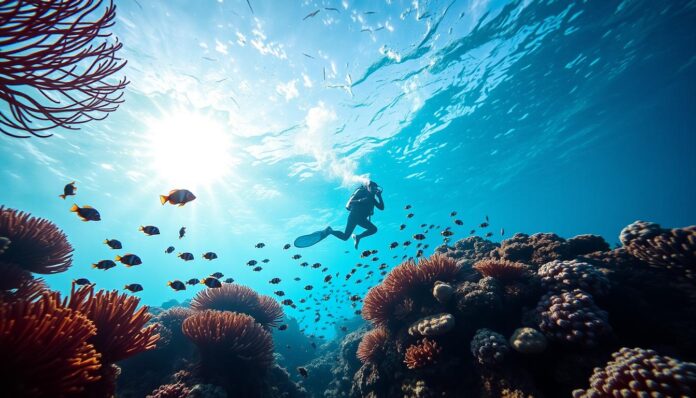Did you know seven types of Clownfish live in El Nido’s clear waters? One of them is famous from “Finding Nemo.” Exploring underwater lets you see these colorful fish up close.
Scuba diving with Clownfish is more than fun. It’s a peek into a fascinating underwater world. These small, bright fish became famous worldwide after “Finding Nemo.” Now, they’re known as marine stars.
Every dive is a chance to see these amazing fish in their home. You can learn about their social lives and how they live with sea anemones. Clownfish show us the beauty and complexity of the ocean.
Key Takeaways – Diving with Clownfish
- Discover seven Clownfish species in locations like El Nido
- Experience the unique underwater world of marine ecosystems
- Learn about Clownfish behavior and survival strategies
- Explore the impact of marine conservation efforts
- Understand the fascinating symbiotic relationships in ocean environments
What are Clownfish?
Explore the amazing world of clownfish, the colorful and lively fish of coral reefs. These small but fascinating fish have won the hearts of many.
Clownfish are part of the Amphiprioninae subfamily. This group is diverse and vital to marine life. Their unique bond with sea anemones is what makes them stand out.
Overview of Clownfish Species
There are about 30 different clownfish species. Each one is unique and adds to the diversity of marine life.
- Clark’s Anemonefish: Males grow to 10 cm, females up to 15 cm
- False Clown Anemonefish: Typically reach 11 cm in length
- Red Saddleback Anemonefish: Can grow to 12 cm
- Skunk Anemonefish: Range from 5-10 cm
Unique Features of Clownfish
Clownfish are known for their special traits:
- Born male, with ability to change sex
- Live in colonies of 5-6 members
- Bright orange, white, and black coloration
- Small size making them perfect for hiding
Their Role in Marine Ecosystems
Clownfish are more than just colorful fish. They are key to keeping coral reefs healthy. They live in a special bond with sea anemones.
| Ecosystem Contribution | Details |
|---|---|
| Food Sources | Plankton, algae, anemone leftovers |
| Habitat Support | Fewer than 20 anemone species support their symbiotic lifestyle |
| Biodiversity | Critical to coral reef ecosystem balance |
“In the complex underwater world, clownfish represent nature’s incredible capacity for cooperation and adaptation.” – Marine Biologist
The Best Locations for Scuba Diving with Clownfish
Tropical destination diving lets you see the amazing world of clownfish in their natural home. These colorful creatures live in some of the most stunning underwater places on Earth.
Top Destinations for Clownfish Encounters
For a memorable clownfish dive, you have many top spots to pick from. The best places include:
Asia:
- Indonesia: Indonesia is a treasure trove of dive sites where you can encounter various clownfish species. Locations such as the Bunaken Marine Park in North Sulawesi and the Komodo National Park offer rich biodiversity and stunning coral reefs.
- Philippines: The Philippines boasts numerous world-class dive sites, including Anilao and the Tubbataha Reefs Natural Park. These locations offer an abundance of clownfish species, vibrant coral gardens, and the opportunity to witness other marine marvels.
- Egypt: The Red Sea off the coast of Egypt is renowned for its exceptional diving opportunities. Destinations like Sharm El Sheikh, Hurghada, and Dahab offer divers the chance to encounter clownfish amidst stunning coral formations and vibrant marine life.
- Seychelles: The Seychelles islands are home to some of the world’s most pristine and picturesque dive sites. Explore locations like the Aldabra Atoll and the St. Pierre Island Marine National Park for a chance to dive alongside clownfish in crystal-clear waters.
- Bonaire: Bonaire, located in the Dutch Caribbean, is a paradise for divers. The Bonaire National Marine Park offers excellent visibility, healthy coral reefs, and the opportunity to encounter clownfish in their natural habitat.
- Cayman Islands: The Cayman Islands are renowned for their thriving marine life and stunning dive sites. Destinations like Little Cayman and Cayman Brac provide the perfect backdrop for encountering clownfish amidst colorful coral formations.
- Belize: Belize is a top destination for divers seeking encounters with clownfish. The Belize Barrier Reef Reserve System, a UNESCO World Heritage Site, offers pristine reefs, abundant marine life, and the chance to dive alongside these captivating fish.
- Honduras: The Bay Islands of Honduras, including Roatan and Utila, are popular dive destinations with diverse marine ecosystems. Explore the vibrant coral reefs and encounter clownfish as they dart among the anemones.
- Greece: The Greek islands offer captivating diving experiences, with clownfish being a common sight. Locations like the Ionian Islands and the Cyclades provide excellent conditions for underwater exploration and encounters with these charming fish.
- Spain: The Mediterranean coast of Spain offers a variety of dive sites teeming with marine life. Explore the Costa Brava, the Balearic Islands, or the Canary Islands to immerse yourself in the underwater world of clownfish.
- Australia: Australia is renowned for its remarkable dive sites, including the Great Barrier Reef. Dive locations like the Ribbon Reefs and the Cod Hole offer excellent opportunities to encounter numerous clownfish species amidst the world’s largest coral reef ecosystem.
- Papua New Guinea: The waters of Papua New Guinea are home to an incredible array of marine biodiversity. Dive sites in Milne Bay and Kimbe Bay provide unique encounters with clownfish and a wealth of other fascinating marine species.
- Mexico: Mexico offers a range of exceptional dive destinations, including the Yucatan Peninsula and the Cozumel Marine Park. These areas are known for their clear waters, beautiful coral formations, and opportunities to dive with clownfish.
- United States: In the United States, the Florida Keys and the Hawaiian Islands are popular destinations for divers. Explore the vibrant reefs of Key Largo or the underwater wonderland of Molokini Crater for encounters with clownfish and a diverse marine ecosystem.
- Galapagos Islands, Ecuador: The Galapagos Islands, a UNESCO World Heritage Site, provide a unique diving experience. Encounter not only clownfish but also endemic species and marine giants like sea turtles, hammerhead sharks, and marine iguanas.
- Brazil: Brazil offers excellent diving opportunities along its extensive coastline. Locations like Fernando de Noronha and the Abrolhos Archipelago showcase stunning underwater landscapes and encounters with clownfish.
Each of these destinations provides a unique and unforgettable experience for divers seeking to interact with clownfish. Remember to plan your dive trips carefully, consider the best time to visit, and adhere to local regulations to ensure a responsible and enjoyable dive adventure.
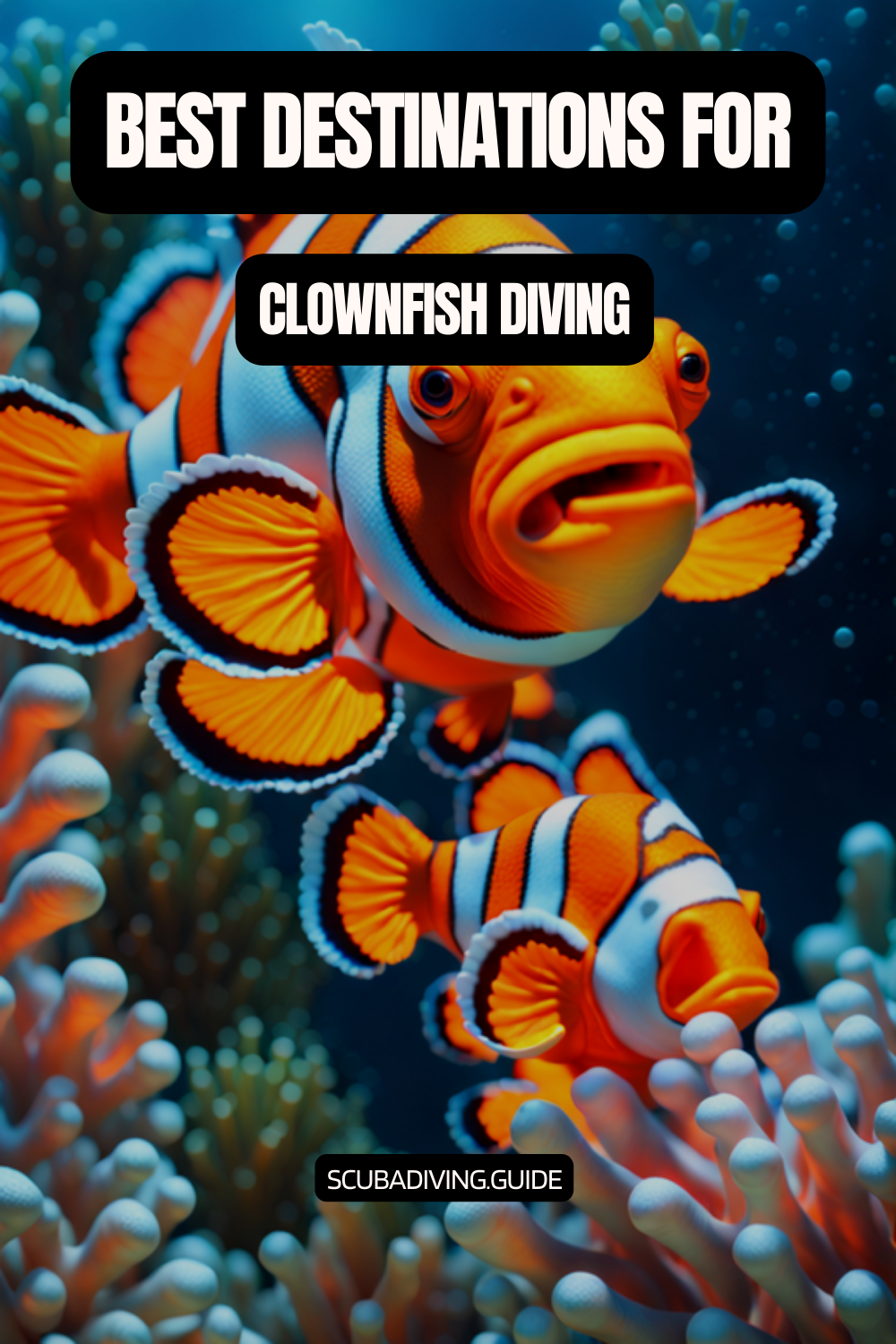
- Great Barrier Reef, Australia
- Raja Ampat, Indonesia
- El Nido, Philippines
- Fiji Islands
- Thailand’s Andaman Sea
Coral Reefs: The Clownfish Habitat
Coral reefs are where clownfish live, giving them food and shelter. These underwater worlds are full of life, with clownfish and sea anemones living together.
| Region | Clownfish Species | Depth Range |
|---|---|---|
| Pacific Ocean | 20+ species | 2-30 meters |
| Indian Ocean | 15+ species | 3-25 meters |
| Red Sea | 5-7 species | 1-20 meters |
Seasonal Considerations for Diving
When planning your dive, think about the season. Look at water temperature, how clear the water is, and when marine life is most active.
“The best time to observe clownfish is during calm sea conditions with optimal water clarity.” – Marine Biology Research Institute
When is the best time to dive? It depends on where you are. For example, Thailand’s Andaman Sea is great from November to April. Indonesia’s Raja Ampat is best from October to April.
Safety Tips for Scuba Diving
Exploring the underwater world of clownfish is exciting but requires safety first. Being well-prepared and knowing the basics can make a dive memorable and safe.
Choosing the right scuba gear is key. Divers need reliable equipment to stay safe and comfortable underwater.
Essential Safety Equipment
Every diver needs the right safety gear to avoid risks. The most important items are:
- Reliable dive mask with proper fit
- High-quality regulators
- Buoyancy compensator device (BCD)
- Dive computer for tracking depth and time
- Backup air source
Understanding Underwater Signals
Underwater, we use hand signals to communicate. These signals help us share important info quickly and clearly.
| Signal | Meaning |
|---|---|
| Thumbs Up | End of dive/Return to surface |
| OK Sign | Everything is fine |
| Horizontal Slashing Motion | Problem or Emergency |
Diving with a Buddy
The buddy system is vital in scuba diving. PADI courses teach that diving alone is risky. Staying close to your buddy can greatly reduce accident chances.
“Safety in diving is not about perfection, but preparation and awareness.” – Professional Diving Instructor
Those interested in diving should take PADI courses. These teach more than just how to use gear. They prepare divers for different underwater situations.
Preparing for Your Dive
Exploring underwater needs careful planning, like when you want to see clownfish. The right scuba gear can make your dive amazing.
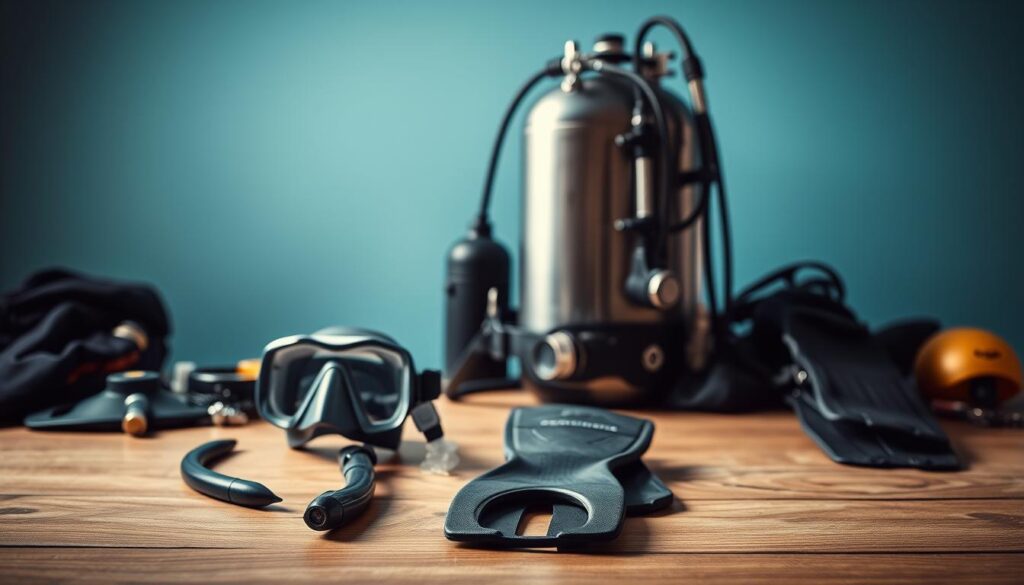
Selecting Your Essential Scuba Gear
Choosing the right gear is key for a safe and fun dive. Experts suggest a detailed checklist. It should include:
- Well-fitted mask with anti-fog coating
- Comfortable wetsuit for the water temperature
- Reliable diving fins for good movement
- Buoyancy control device (BCD)
- Oxygen tank with the right pressure
Pre-Dive Preparation Checklist
A good pre-dive briefing is essential for safety and fun. Important points are:
- Reviewing the dive site conditions
- Knowing emergency plans
- Checking your fitness
- Testing your gear
| Gear Item | Purpose | Check Point |
|---|---|---|
| Mask | Clear vision underwater | No cracks, proper seal |
| Wetsuit | Temperature protection | Correct size, no tears |
| BCD | Buoyancy control | Inflation/deflation test |
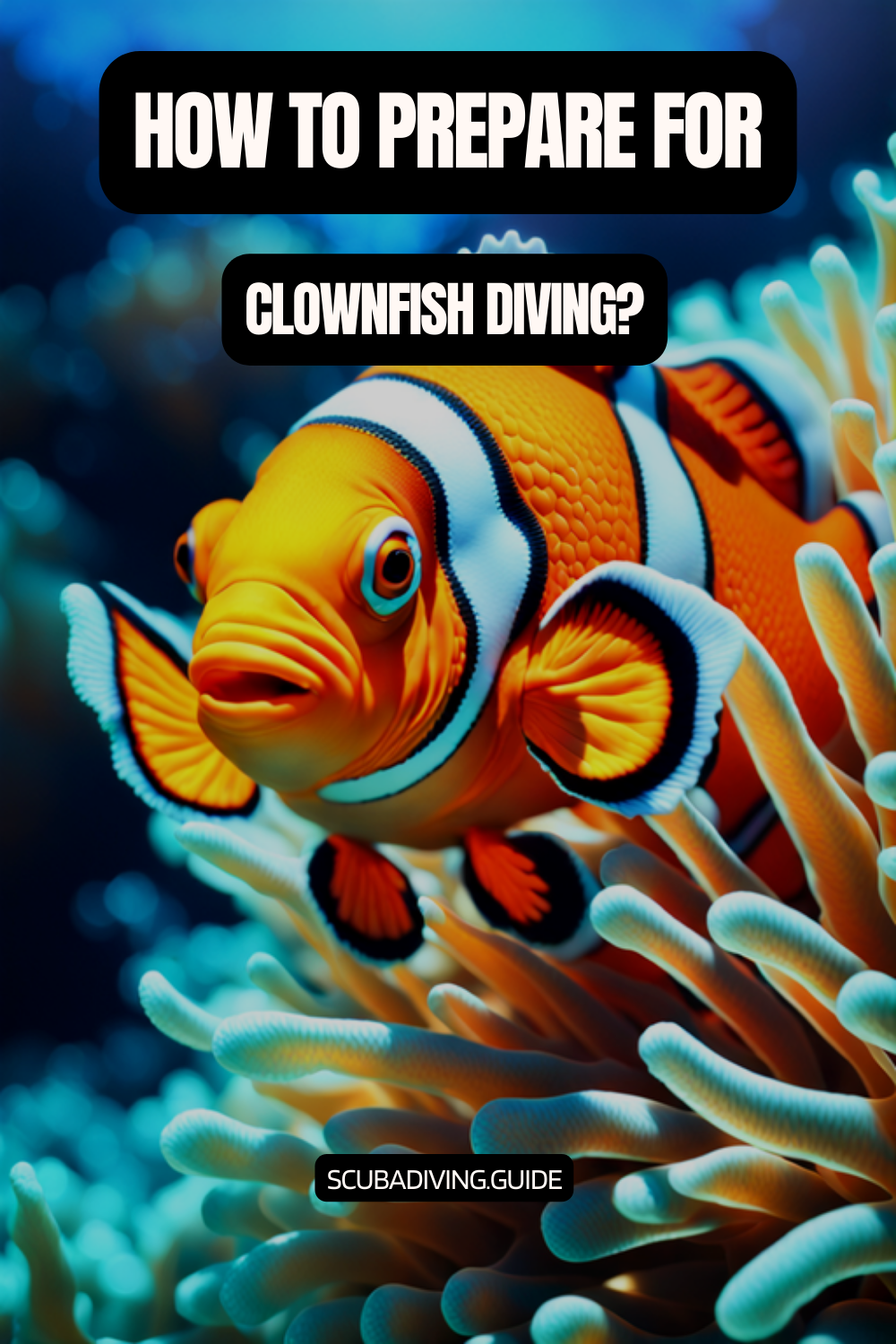
Health Considerations for Diving
Being physically ready is important for diving. Ear equalization techniques and good heart health are key. Always check with a doctor before diving.
“Preparation is the key to unlocking remarkable underwater experiences.” – Diving Professionals Network
The Dive Experience: What to Expect
Exploring clownfish habitats underwater is an amazing experience. It’s perfect for both new and seasoned divers. The underwater world is full of vibrant colors and life, where clownfish build their homes.
Diving Techniques for Marine Encounters
To have a great time with clownfish, you need to know how to dive right. Here are some key skills:
- Slow, controlled movements
- Precise buoyancy control
- Minimal disturbance to marine environments
- Respectful observation distances
Interacting with Clownfish
Clownfish are very protective of their homes. Marine life encounters need a careful touch. Keep at least 3-4 feet away from their anemone to not stress them out.
“Respect the marine ecosystem, and it will reveal its most incredible secrets.” – Marine Biologist Research Team
Exploring Surrounding Marine Life
There’s more to see than just clownfish. Divers will find a world full of different sea creatures. At a depth of 15 meters, you get a great view of underwater exploration.
| Dive Characteristic | Typical Parameters |
|---|---|
| Recommended Depth | 15 meters |
| Typical Dive Duration | 45-60 minutes |
| Marine Species Diversity | High in tropical reef environments |
Every dive is a chance to see the beauty of marine life. Clownfish are key to showing us the wonders of the sea.
Clownfish Behavior and Habitat
Dive into the fascinating world of clownfish. Here, marine life encounters show us how these fish survive. They have amazing adaptations that make them experts of their underwater world.
Clownfish live in tropical coral reefs in the Indian and Pacific Oceans. There are 28 different species, each with its own traits. They survive thanks to a special bond with sea anemones, which protects them and helps both species.
Territorial Dynamics
Clownfish live in groups with a clear social structure. These groups usually have:
- A dominant female
- A breeding male
- Several non-breeding juveniles
Symbiotic Relationship with Anemones
The bond between clownfish and sea anemones is truly amazing. Clownfish can’t get stung by anemones because of a special mucus on their skin.
“Nature’s most intriguing dance is between the clownfish and its anemone home” – Marine Biologist
Feeding and Reproduction
Clownfish eat a variety of foods, including:
- Algae
- Zooplankton
- Small crustaceans
Clownfish reproduce in a unique way. They start as males and can change to females if needed. This ensures the group’s survival.
| Characteristic | Details |
|---|---|
| Habitat Range | Tropical Coral Reefs |
| Average Size | 4-5 inches (10-13 cm) |
| Lifespan | 7-10 years in wild |
| Reproduction Cycle | Eggs laid twice monthly |
These marine wonders amaze scientists and divers. They give us a peek into the complex world of underwater ecosystems.
Photography Tips for Capturing Clownfish
Exploring underwater is a magical chance for photographers to see clownfish up close. These colorful sea creatures are a big challenge for those wanting to capture their lives.
Getting good at underwater photography takes special skills and knowledge. It’s important to care for the ocean and its creatures while taking amazing photos.
Best Camera Settings for Underwater
Knowing the right camera settings is key for underwater photos:
- Low ISO settings keep colors bright
- Closed aperture helps with depth
- Fast shutter speeds stop fish from moving
Experts say using two strobes at 10 and 2 o’clock can make photos 50% brighter than one strobe.
Framing Your Shot
Getting the perfect shot of clownfish takes patience and the right spot. With 28 species around the world, each photo is special. The Coral Triangle is great for seeing up to seven species on one dive.
“The art of underwater photography is about respect and observation, not intrusion.” – Marine Photography Expert
Ethics of Wildlife Photography
Good photographers know not to disturb the sea life. Watching from afar can make photos 50% better and protect the ocean.
- Keep a safe distance from sea creatures
- Don’t mess with their homes
- Put animal safety first, even if it means missing a shot
Every photo is a chance to show how amazing our ocean is and why we need to protect it.
Conservation Efforts for Clownfish
Clownfish face big challenges in the ocean. Eco-tourism helps protect these colorful fish and their homes. We need to save coral reefs and the life they support.
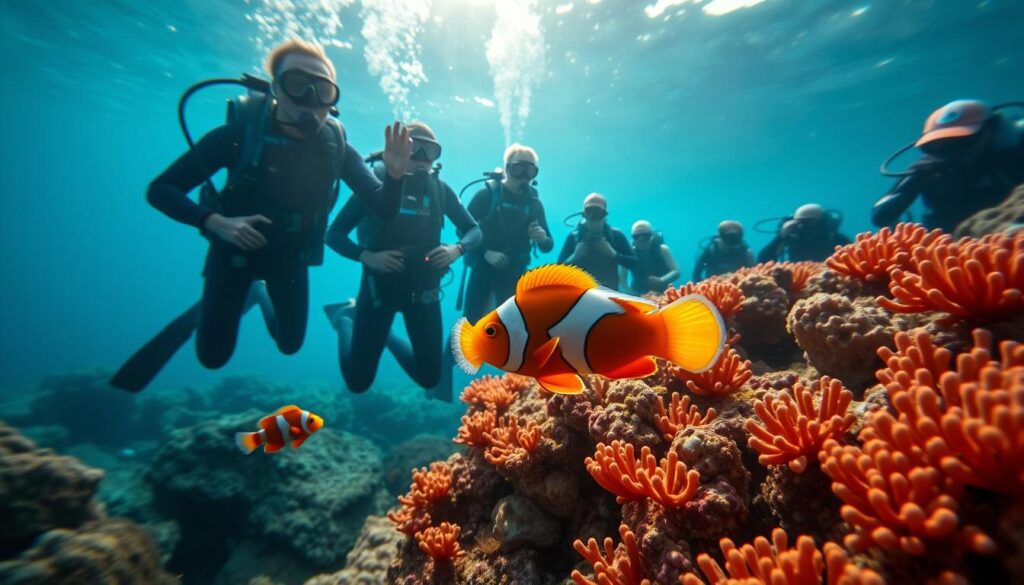
Threats to Their Habitat
Clownfish are under a lot of pressure. The main issues are:
- Climate change harms coral reefs
- Warmer oceans threaten marine life
- Bad aquarium trade hurts them
- Pollution damages their homes
“Protecting 30% of our oceans by 2030 is key for marine life” – Global Conservation Alliance
How Divers Can Help
Diving can help protect coral reefs. Divers can:
- Use diving methods that don’t harm the reef
- Support local conservation efforts
- Tell others about reef damage
- Teach people about saving marine life
Organizations Supporting Clownfish Conservation
Many groups work hard to save clownfish and their homes. They do research, support conservation, and spread the word about saving the ocean.
By supporting these efforts, we can help clownfish and the coral reefs they live in survive.
Learning Objectives for Divers
Exploring the underwater world is a thrilling adventure for marine lovers. It’s a chance to dive deep into the fascinating world of marine biodiversity. For those passionate about marine life, understanding the underwater ecosystems is a key part of their journey.
Divers on underwater adventures can learn important skills and knowledge. These goals help them become informed advocates for marine ecosystems.
Understanding Marine Biodiversity
Marine ecosystems are complex and full of life. Here are some amazing facts about ocean biodiversity:
- Coral reefs support about 25% of all marine species
- The total number of species in coral reef ecosystems is estimated at 1 million
- These ecosystems cover less than 1% of the ocean floor
Recognizing Different Species
Learning to identify different marine organisms is key. Divers can learn to spot various marine creatures, like clownfish.
“Knowledge transforms observation into understanding” – Marine Biology Educators
Environmental Awareness Underwater
Being environmentally conscious is vital during marine life encounters. Divers help protect fragile underwater ecosystems by:
- Minimizing physical contact with marine habitats
- Practicing responsible diving techniques
- Supporting conservation efforts
By embracing these learning objectives, divers contribute to marine research and environmental preservation while enjoying breathtaking underwater experiences.
What You Need to Know Before You Go
Planning a tropical diving trip needs careful thought. You might dream of seeing colorful coral reefs or meeting marine creatures. Knowing what you need is key for a great dive.
Age and Certification Requirements
Starting your diving journey means knowing about certifications. PADI offers various levels for all skill levels:
- Minimum age for junior certification: 10 years old
- Open Water Diver certification requires:
- Basic swimming skills
- Medical clearance
- Completion of theoretical and practical training
“Every great adventure begins with proper preparation” – Diving Experts
Environmental Regulations
Responsible diving means following local marine rules. Important points include:
- Maintaining safe distance from marine life
- Using reef-safe sunscreen
- Avoiding touching coral or disturbing underwater ecosystems
Booking Your Scuba Experience
Choosing the right dive operator is vital for a safe and fun dive. Look at these when booking:
- Verified PADI certification credentials
- Recent equipment maintenance records
- Experienced and professionally trained guides
- Comprehensive safety protocols
Pro tip: Always check your dive operator’s reputation online and ask for recommendations from other divers.
The Joy of Dive Travel
Tropical destination diving is more than just exploring the ocean. It opens doors to rich cultural experiences. These experiences turn a simple dive trip into a memorable journey of discovery and connection.
Exploring Cultural Landscapes
Responsible eco-tourism is not just about the sea. Visiting tropical diving spots lets you connect with local communities and traditions. Each place has its own cultural story:
- Traditional fishing villages
- Local culinary experiences
- Historical sites near marine environments
Making Meaningful Connections
Diving can bridge people from different places. The love for marine life breaks down language barriers. It creates real connections that stay with you long after the trip.
“The ocean connects all humanity, revealing our shared responsibility to protect and cherish our planet’s most remarkable ecosystems.”
Local Cuisine and Attractions
Every tropical diving spot has its own land-based wonders. From enjoying fresh seafood to exploring cultural sites, divers can make their underwater adventures richer with real local experiences.
Fiji’s marine ecosystem is among the most diverse on Earth. It’s a perfect place for those who want to see underwater wonders and dive deep into local culture.
Post-Dive: Reflecting on Your Experience
After an amazing dive with clownfish, your experience is more than just a moment. It’s about starting a journey of conservation awareness. Your time with these colorful sea creatures can inspire others to care for our oceans.
Sharing Your Dive Stories
When you share your snorkeling stories, make them educational. Use platforms like Instagram and dive forums to show your photos. This helps spread the word about marine life and the need to protect it.
Tips for Sustainable Travel
Practicing sustainable diving is key to saving our oceans. Look for dive operators who care about the environment. Always be gentle with marine life and follow rules to protect coral reefs.
Further Reading and Resources on Clownfish
Learn more about clownfish by reading scientific articles from PADI, National Geographic, and marine research groups. These sources will teach you about clownfish behavior and their importance in the ocean. You’ll also learn about the challenges they face.
Common Marine Species Found Alongside Clownfish
Diving with clownfish offers an opportunity to encounter not only these captivating fish but also a diverse array of marine species that share their vibrant coral reef habitats. Exploring the underwater world alongside clownfish unveils a rich tapestry of biodiversity and ecological interactions. Here are some common marine species you may encounter while diving with clownfish.
- Anemones: Anemones are the iconic hosts of clownfish. These invertebrate creatures resemble colorful underwater flowers and provide shelter and protection for the clownfish. The symbiotic relationship between clownfish and anemones is a fascinating example of mutualism, where both species benefit from their association.
- Clownfish Species: While clownfish are the stars of the show, various species may be encountered during your dive. Some popular species include the orange clownfish (Amphiprion percula), the false clownfish (Amphiprion ocellaris), the pink skunk clownfish (Amphiprion perideraion), and the tomato clownfish (Amphiprion frenatus). Each species has its unique coloration and behaviors, adding to the enchantment of your underwater experience.
- Damselfish: Damselfish are commonly found in the same coral reef habitats as clownfish. These small, colorful fish often exhibit territorial behavior and can be seen darting among the corals. Their vibrant colors and energetic movements add to the dynamic atmosphere of the reef.
- Butterflyfish: Butterflyfish are known for their striking patterns and graceful swimming. These elegant fish often accompany clownfish in their underwater journeys. Their vibrant colors and distinctive shape make them a delight to observe as they navigate through the coral reefs.
- Angelfish: Angelfish are another common sight in clownfish habitats. With their vibrant colors and graceful movements, they add a touch of elegance to the underwater scenery. Look out for species such as the regal angelfish (Pygoplites diacanthus) and the emperor angelfish (Pomacanthus imperator) as they glide among the corals.
- Surgeonfish: Surgeonfish, also known as tangs, are recognizable by their laterally compressed bodies and scalpel-like spines on their tails. These herbivorous fish play a vital role in maintaining the health of the reef ecosystem by grazing on algae. Their bright colors and busy foraging behaviors bring liveliness to the reef.
- Cleaner Shrimp: Cleaner shrimp, such as the vibrant peppermint shrimp (Lysmata wurdemanni), are commonly found near clownfish and anemones. These small, shrimp-like crustaceans play a crucial role in cleaning other fish by removing parasites and dead skin. Observing their intricate cleaning behavior is both fascinating and entertaining.
- Sea Urchins: Sea urchins, with their spiny exteriors, are often spotted nestled among the corals. These echinoderms play a role in reef ecosystems by controlling algae growth and providing shelter for various marine organisms. Take care to avoid touching or disturbing these delicate creatures.
Encountering these diverse marine species alongside clownfish adds depth and richness to your diving experience. Observing their interactions, behaviors, and unique adaptations provides a greater understanding of the interconnectedness and beauty of the underwater world.
FAQ – Diving with Clownfish
Are clownfish dangerous to divers?
No, they’re not! Clownfish are small and peaceful. They like to hide in their anemone homes. They might seem curious but are not aggressive. It’s best to keep a respectful distance to not disturb them.
Do I need special certification to dive with clownfish?
You don’t need a special “clownfish-specific” certification. But, most dive operators suggest a PADI Open Water Diver certification or something similar. Beginners can take introductory courses or join guided snorkeling trips to see these amazing fish.
Where are the best locations to see clownfish in their natural habitat?
The Great Barrier Reef in Australia, Raja Ampat in Indonesia, and El Nido in the Philippines are top spots. These places have vibrant coral reefs that are perfect for clownfish and their anemone friends.
What equipment do I need for diving with clownfish?
You’ll need a good wetsuit, mask, fins, and an underwater camera if you want to take pictures. Also, a dive computer and regulator are essential. Make sure your scuba gear is in good condition. You can rent from reputable dive centers at your destination.
How can I photograph clownfish without disturbing them?
Move slowly and keep neutral buoyancy. Use a fast shutter speed and natural light. Keep a safe distance from the clownfish and their anemone. Always put the marine life’s safety first, even if it means missing a photo.
Are clownfish endangered?
Not all clownfish are endangered, but they face threats like climate change and habitat loss. By diving responsibly and supporting marine conservation, you can help protect these amazing fish.
What makes the relationship between clownfish and sea anemones unique?
It’s a special symbiotic relationship. Clownfish are immune to anemone stings and help their host. The anemone gives them shelter and protection from predators. It’s one of nature’s most fascinating partnerships.
How can I contribute to clownfish conservation?
Dive responsibly by not touching marine life and using reef-safe sunscreen. Support local conservation groups and spread the word about protecting marine ecosystems. Every action helps in preserving these incredible habitats.
